Research Article Open Access
Laboratory Scale Bioremediation of the Yamuna Water with Effective Microbes (EM) Technology and Nanotechnology
| J.N Shrivastava*, Nupur Raghav and Abha Singh | |
| Department of Botany, Microbiology Laboratory, DEI, Dayalbagh, Agra, India | |
| Corresponding Author : | J.N Shrivastava Department of Botany, Microbiology Laboratory DEI, Dayalbagh, Agra, India E-mail: janendra.srivastava@gmail.com |
| Received May 31, 2012; Accepted July 18, 2012; Published July 20, 2012 | |
| Citation: Shrivastava JN, Raghav N, Singh A (2012) Laboratory Scale Bioremediation of the Yamuna Water with Effective Microbes (EM) Technology and Nanotechnology. J Bioremed Biodeg 3:160. doi:10.4172/2155-6199.1000160 | |
| Copyright: © 2012 Shrivastava JN, et al. This is an open-a ccess article distributed under the terms of the Creative Commons Attribution License, which permits unrestricted use, distribution, and reproduction in any medium, provided the original author and source are credited. | |
Related article at Pubmed Pubmed  Scholar Google Scholar Google |
|
Visit for more related articles at Journal of Bioremediation & Biodegradation
Abstract
In present study, Yamuna water sample was tested and treated with EM technology (bacterial monocultures) and Nanotechnology (AgNO3 synthesized bacterial monocultures). After treatment, a sharp reduction was observed in all the physical and chemical parameters in the sample throughout the investigations. The bacterial monocultures treated water sample showed a sharp reduction in BOD i.e. 60-85% and 50-80% in COD while AgNO3 synthesized bacterial monocultures showed 85-95% reduction in BOD and 25-45% reduction in COD. The study concludes that both the technologies (EM technology and Nanotechnology) were effective in the reduction of water impurities but EM technology was more effective in reducing chemical pollutants to the permissible limits in comparison to the nanotechnology, while nanotechnology reduced biological contaminants more than EM technology.
| Keywords |
| Bioremediation; Chemical pollutants; Nanotechnology; Effective microbes; Yamuna |
| Abbreviations |
| EM: Effective microbes; DO: Dissolved Oxygen; COD: Chemical Oxygen Demand; BOD: Biological Oxygen Demand; TDS: Total Dissolved Solids; TSS: Total Suspended Solids; TS: Total Solids; mg L-1: milligrams per Liter; AgNO3: Silver Nitrate; mM: mille Molar; nm: Nanometers; kv: Kilovolts; mA: mille Ampere |
| Introduction |
| Water pollution is the prime cause of unavailability of the suitable water for irrigation purpose. Since many industries discharge their effluent on to open lands because of high cost of dilution and inadequate treatment facilities effective and profitable utilization of the effluent of the industries needs greater attention [1]. According to 1980 study by the WHO at least 30,000 people die every day because of unsanitary water supply. High levels of pollutants mainly organic matter in river water causes an increase in Biological Oxygen Demand, Chemical Oxygen Demand, total dissolved solids and total suspended solids, they make the water unsuitable for drinking, irrigation or any other use [2]. Bioremediation is a pollution control technology that uses biological system to catalyze the degradation or transformation of various toxic chemicals to less toxic forms [3]. Bioremediation is cost effective and efficient method of decontamination that has become increasingly popular now days to remove environmental pollution [4]. |
| EM technology is a technique in which the waste water is treated by effective microbes which can be recycled for the irrigation purpose [5]. The technology of effective microorganisms was developed during the 1970’s at the University of Ryukyus, Okinawa, Japan [6]. Studies have shown that EM may have a number of applications, including agriculture, livestock, gardening & landscaping, composting, bioremediation, cleaning septic tanks, algal control & household uses [7]. The practical application was developed by Professor Teuro Higa. He has devoted much of his scientific career to isolating & selecting different microbes for beneficial effects on soils & plants. He has found microbes that can coexist in mixed cultures & are physiologically compatible with one another. When these cultures are introduced into the natural environment, their individual beneficial effects are greatly magnified in a synergistic fashion [8]. A microbial inoculant containing many kinds of naturally occurring beneficial microbes called ‘Effective Microorganisms’ has been used widely in nature and organic farming [9]. EM detoxifies contaminated water and is ideal for biological balance. EM converts a degraded ecosystem to one that is productive and contains useful microorganisms [10]. |
| New technologies are being produced to assist in the treatment and disposal of sewage sludge, conforming to strict environmental regulations. One of these new technologies is Nanotechnology. The term nanotechnology was coined by science university professor Norio Taniguchi in 1974 [11]. Nanotechnology deals with the object on the order of a nanometer in size. Nanotechnology is used for the treatment of surface water, ground water and waste water contaminated by toxic metal ions, organic and inorganic solutes and microorganism. Due to their unique activity toward recalcitrant contaminants many nonmaterial are under active research and development for use in the treatment of water [12]. |
| Hence in present investigation an attempt has been made to remedify the Yamuna waste water by non-synthesized and Silver Nitrate (AgNO3) synthesized bacterial isolates. |
| Materials and Methods |
| Collection of water samples |
| Water samples were collected in sterilized BOD bottles, from the river Yamuna situated in the city of Taj - Agra, India, receiving the huge loads of industrial, agricultural and domestic wastes resulting in large scale deterioration of the water quality and affects the physico-chemical parameters of water. |
| Purification of targeted bacteria |
| The bacteria used, Bacillus subtilis, B. cereus, B. fusiformis, B. thuringiensis, Escherichia coli, Rhodopseudomonas palustris, Rhodobacter spheroides, Lactobacillus sp. were obtained from the Microbiology Lab (Department of Botany), Dayalbagh Educational Institute, Agra. Bacterial cultures were picked up from the stock cultures with the help of needle & were transferred on to the petridishes containing NAM solid medium ( Peptone-5 g, Beef extract-3 g, Sodium chloride-5 g, Agar-20 g, pH-7, Distilled water-1000 ml) directly and incubated at 37ºC for 24-48 h. |
| Synthesis of silver nanoparticles |
| Silver nanoparticles were synthesized from bacterial culture using AgNO3 solution. Isolated colonies of bacteria were sub cultured into 50 ml of nutrient broth containing 3.5 mM AgNO3. The broth were inoculated with a loopful of bacteria and incubated for a period of 7 days in darkness at room temperature. Upon visual observation, the culture incubated in presence of AgNO3 showed a colour change from white to brown [13]. |
| Characterization of silver nanoparticles |
| After synthesis of silver nanoparticle characterization was done using Ultraviolet-visible spectrophotometery, FTIR (Fourier transform Infra-Red) and XRD (X-Ray Diffraction). Nanoparticles were analysed under UV for their specificity. FTIR was done to identify the groups linked with the nanoparticles. The size and structure of nanoparticles were checked by X-ray diffraction (XRD) spectrum. |
| Ultraviolet-Visible Spectroscopy: UV-vis spectroscopy analysis of silver nanoparticles produced were carried out as a function of bioreduction time at room temperature on ELICO UV spectrophotometers at a resolution of 400-800nm. |
| Fourier Transform Infrared (FTIR) analysis: FTIR spectrum of a compound represents its energy absorption pattern in the infrared region and is obtained by plotting percent absorbance or transmittance of Infrared Radiation as a function of wavelength or wave number over a particular range. FTIR spectra were recorded on Perkin Elmer spectra MRX-1 model. |
| X-ray diffraction studies: The formation and quality of compounds were checked by X-ray diffraction (XRD) spectrum. The XRD pattern was measured by dried powder of silver nanoparticles prepared in sample by an X’Pert Pro X-ray diffractophotometer operated at a voltage of 40 kV and a current of 30 mA with Cu Kα radiation in the range of 20°- 80°. |
| To check the initial physico-chemical parameters (colour, odour, pH, BOD, COD, DO) of collected waste water samples: |
| The analysis of initial phsico-chemical parameters of collected wastewater samples were carried out by APHA guidelines [14]. |
| Estimation of above mentioned physico-chemical parameters by:- |
| a. Using non synthesized monoculture Effective microbes and |
| b. AgNO3 synthesized Effective Microbes. |
| The efficiency of non-synthesized effective microbes and AgNO3 synthesized microbes was evaluated for the reduction of different physico-chemical parameters of various water samples [14]. The physico chemical parameters of the water samples were analyzed before treatment. For bacterial monoculture treatment, 5% of Bacterial suspension (individually) was inoculated into the water samples and incubated in an incubator. After incubation the samples were analyzed for different physico-chemical parameters. |
| For AgNO3 synthesized effective microbes treatment, 5% of AgNO3 synthesized individual bacteria were inoculated into the water samples and kept for 72 h. in incubator shaker. After incubation the samples were analyzed for different physico-chemical parameters. |
| Results and Discussion |
| The physico-chemical characteristics of Yamuna water before treatment is presented in table 1.The untreated water sample was dark yellowish in colour, foul odour, alkaline in nature (7.8), with high TDS (16.782 mg L-1), TSS (5.822 mg L-1), DO (4 mg L-1), BOD (8.24 mg L-1) and COD (43.4 mg L-1). After EM treatment, all the parameters showed sharp reduction i.e. colourless, odourless, pH value ranged from 6.8-7.5, TDS (3.31-16.5 mg L-1), (Table 2) DO (10-11.2 mg L-1), BOD (1.6-6.4 mg L-1) and COD (8.6-29.2 mg L-1) (Table 3). The result are similar with the report of Mishra and Tripathi [15]. They reported a significant variation in values of DO, BOD, and COD between untreated and treated sewage waste water. The treated sewage water showed a sharp reduction in BOD (84.9%) and COD (79.9%) and DO content of treated sewage increased by 62.4%. DO, BOD and COD are important parameters which should be determined to perform the sewage quality analysis. These findings are similar to that of Joshi and Sharma [16]. They performed bioremediation of sewage through bacterial inoculation under in vitro and reported a reduction in BOD and COD after 24, 48 and 72 h. Maximum reduction (79.45% in BOD and 72.25% in COD) was observed after inoculation period of 72 h. with bacterial cultures. |
| Our results are in concordance to that of Nathan and Robert [17]. They observed significant decrease in pH levels with increased EM dose, improved settlement of the sludge, but a significant increase in BOD by Effective Micro-organisms. EM includes Lactobacillus plantarum, L. casei, Streptococcus lactis, Rhodopseudomonas palustris, Rhodobacter sphaeroides, S. cerevisiae, Candida utilis, Streptomyces albus, S. griseus, Aspergillus and Mucor hiemalis. |
| Rashid and West [18]. tested the duckweed growth and EM application on dairy waste water pollutants and pathogen control using E.coli. |
| In AgNO3 synthesized effective microbes treatment, a vast variation in physico-chemical parameters were analyzed:-The waste water sample became colourless, odourless, pH value ranged from 7.26–7.59, TDS (0.04-0.76 mg L-1) (Table 2) DO (11.2–14.8 mg L-1), BOD (0.2-1.2 mg L-1), COD (58.9-82.9 mg L-1) (Table 3) |
| Theron [19] agreed the present findings, and reported that nanotechnology is the engineering and art of manipulating matter at the nanoscale (1–100 nm), offers the potential of novel nanomaterials for treatment of surface water, groundwater, and wastewater contaminated by toxic metal ions, organic and inorganic solutes, and microorganisms. The treated water showed a sharp reduction in BOD (95%). DO, BOD and COD are important parameters which should be determined to perform the water quality analysis. Nanoparticles released from different nanomaterials used in our household and industrial commodities find their way through waste disposal routes into the wastewater treatment facilities and end up in wastewater sludge [20]. |
| The present study concludes that both the technologies (EM technology and Nanotechnology) were effective in the reduction of water impurities but EM technology was more effective in reducing chemical pollutants to the permissible limits in comparison to the nanotechnology while nanotechnology reduced biological contaminants more than EM technology. The findings of present study are global interest for a number of primarily reasons because such complicated and waste water use distribution and application system are in operation in a number of countries all over the world. Nanotechnology for water remediation will play a crucial role in water security and consequently the food security of the world [21]. Nanotechnology is going to play an important role in addressing fundamental issues such as health, energy and water [22]. |
| The information presented here will assist to understand the potential problems, weak points and the risk of their own system better. Secondly, it presents an altering monitoring practice, which can be applied in all similar systems and will provide more accurate results. Finally through the results presented here, it was shown that if good, stable and effective waste water treatment is achieved then waste water reused becomes increasingly safe. |
| Characterization of silver nanoparticles |
| UV-Vis Spectroscopy: Reduction of the aqueous silver nitrate ions during exposure to bacteria may be easily followed by UV-Vis spectroscopy. It is well known that Silver nanoparticles exhibit brown colour, this colour arises due to the excitation of surface plasmon vibrations in the silver nanoparticles. The bacterial suspension (prepared in nutrient broth medium) incubated at 36˚C for 7 days. The control retained its original colour i.e. yellow while the silver nitrate treated bacterial suspension turned brown after 7 days due to the formation of silver nanoparticles. The evolution of absorbance spectra emanating from silver nanoparticles over time manifest increasingly sharp absorbance with increasing time of reaction at around 420 nm attributed to surface Plasmon resonance band of nanocrystalline silver particles. In R.palustris and R.spheroides the UV-Vis spectrum showed the presence of one major peak at wavelength 420nm (Figure 1 and Figure 2) |
| FTIR Spectroscopy: The effective bacterial suspension was subjected to infrared spectrophotometer (Model-Perkin Elmer Spectra MRX-13). In Rhodopseudomonas palustris the peak at 3556.1 cm-1 and 1652.8 cm-1 belongs to internally bonded –OH stretching and alkenyl C=C bending. In Rhodobacter spheroides the peaks at 3418.1cm-1 and 1641.6 cm-1 belongs to –OH stretching, Aromatic C=C bending and meta distributed benzene (Figure 3 and Figure 4). |
| X-ray diffraction: The XRD spectrum (Figure 3) showed four different peaks at 38.116°, 44.277°, 64.426° and 77.472°, which are indexed the (111), (200), (220) and (311) of the cubic face-centered silver. The average particle size of silver nanoparticles formed in the process was estimated from Debye-Scherrer’s equation (d=(kλ×180)/β Cos θβ Π) by determining the width of the (111) Bragg’s reflection where k is Scherrer’s constant, λ is the wavelength of the X-rays, β and θβ are full width half maximum of the Bragg angle, the estimated mean size of the particle was 29.18 nm. (Figure 5) |
| Acknowledgements |
| The authors are grateful to Prof. V. G Dass, Director and Prof. D. S Rao Head Department of Botany, for the encouragement and laboratory facilities and UGC for financial support. |
References
|
Tables and Figures at a glance
| Table 1 | Table 2 | Table 3 |
Figures at a glance
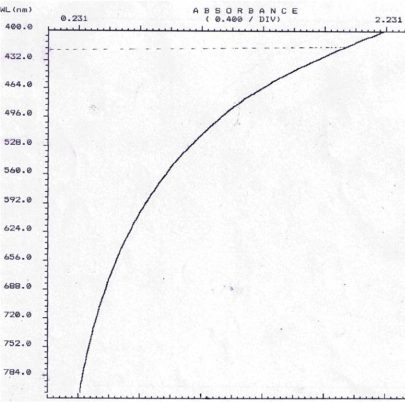 |
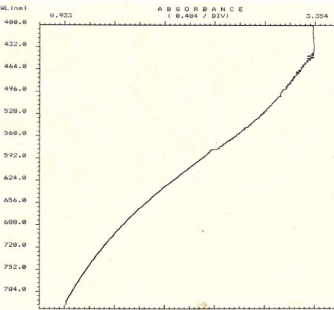 |
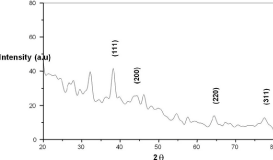 |
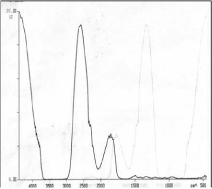 |
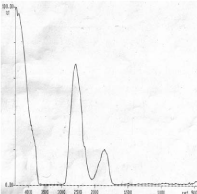 |
| Figure 1 | Figure 2 | Figure 3 | Figure 4 | Figure 5 |
Relevant Topics
- Anaerobic Biodegradation
- Biodegradable Balloons
- Biodegradable Confetti
- Biodegradable Diapers
- Biodegradable Plastics
- Biodegradable Sunscreen
- Biodegradation
- Bioremediation Bacteria
- Bioremediation Oil Spills
- Bioremediation Plants
- Bioremediation Products
- Ex Situ Bioremediation
- Heavy Metal Bioremediation
- In Situ Bioremediation
- Mycoremediation
- Non Biodegradable
- Phytoremediation
- Sewage Water Treatment
- Soil Bioremediation
- Types of Upwelling
- Waste Degredation
- Xenobiotics
Recommended Journals
Article Tools
Article Usage
- Total views: 15434
- [From(publication date):
August-2012 - Apr 04, 2025] - Breakdown by view type
- HTML page views : 10695
- PDF downloads : 4739
